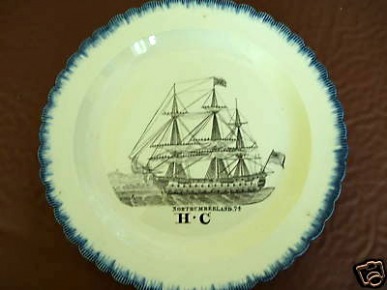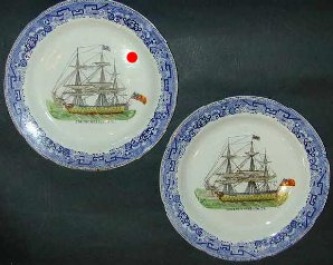|
8/5/2010 0 Comments Missing link?(Please read the previous blog post first.) I've just remembered a plate I saw on eBay last year with a Dixon, Austin & Co impressed mark (top photo). An internet search also yielded two similarly marked plates for sale by Sue Norman. These plates were made 1820–26, which brings them closer to the date HMS Northumberland transported Napoleon to St Helena (1815). I think this could support the theory that Dixon, Phillips & Co started making Northumberland 74 plaques in the 1830s. If a copper transfer plate already existed that could be recycled on plaques, that would help explain the random choice of subject for that decade.
The photos aren't good enough to make a proper comparison of transfers. However, there do appear to be some substantial differences. The upper photo shows a curved-edge transfer (note the cropping of the sea) specifically designed to sit in the centre of a dinner plate. The transfer on the plaque (see previous post) is squarer in design. The side of the ship on the three plates is reflective and light, whereas on the plaques it is hatched and dark. So there are at least two possibilities. Firstly, the transfers could have come from separate copper transfer plates. That wouldn't particularly help our argument (though wouldn't upset it either). Secondly, a single copper transfer plate could have been re-engraved to restore detail lost over time. The engraver could have added bits of sea to square the design off, and make it fit better on a plaque. As an engraver can only add extra lines, not take them away, this would suggest the plates pre-date the plaques. I'm reserving judgement until I see a better photo!
0 Comments
Leave a Reply. |
AuthorStephen Smith lives in London, and is always happy to hear from other collectors. If you have an interesting collection of plaques, and are based in the UK, he will photograph them for you. Free advice given regarding selling and dispersal of a collection, or to those wishing to start one. Just get in touch... Archives
February 2022
AcknowledgementsThis website is indebted to collectors, dealers and enthusiasts who have shared their knowledge or photos. In particular: Ian Holmes, Stephen Duckworth, Dick Henrywood, Norman Lowe, Keith Lovell, Donald H Ryan, Harold Crowder, Jack and Joyce Cockerill, Myrna Schkolne, Elinor Penna, Ian Sharp, Shauna Gregg at the Sunderland Museum, Keith Bell, Martyn Edgell, and Liz Denton.
|

